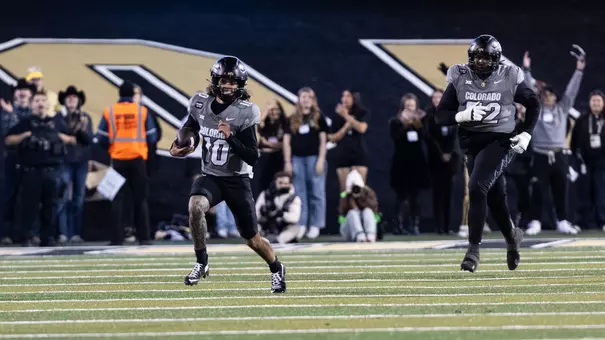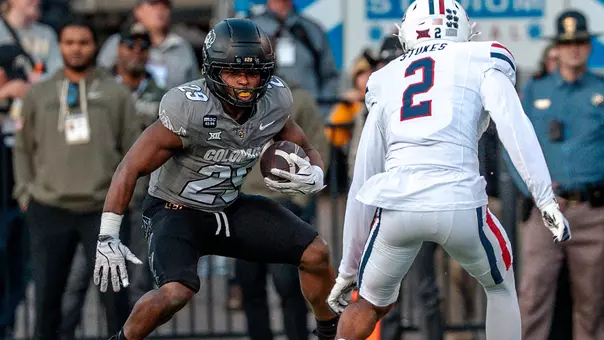Colorado University Athletics

Buffs' Offensive Tweaks Have Produced Added Dimension, Balance
November 23, 2016 | Football, Neill Woelk
BOULDER — Heading into this season, no player in Colorado football history had ever thrown for at least 300 yards and run for at least 100 in the same game.
Zero. Although the list of outstandings Buffs quarterbacks is long — Bobby Anderson, Darian Hagan, Kordell Stewart, Koy Detmer and Joel Klatt, just to name a few — none had ever put up those kinds of dual-threat numbers.
Now there are two names on that list, Sefo Liufau and Steven Montez, a testament not only to their abilities, but to a pair of CU offensive co-coordinators who have tweaked CU's offense to fit those players' skill sets.
Montez, a redshirt freshman, was the first to accomplish the feat, throwing for 333 yards and three touchdowns and rushing for 135 and another score in a 41-38 win over Oregon when Liufau was out with an ankle injury.
Last weekend, a healthy Liufau joined the club, throwing for 345 yards and rushing for 108 yards and three touchdowns in No. 9 Colorado's 38-24 win over No. 20 Washington State.
It's not a coincidence — and there's even a little irony involved. While it was Montez who first accomplished the feat, it is Liufau for whom this season's CU offense is designed. The fact that Montez's skill set perfectly fits the offensive concoction of Buffs co-coordinators Brian Lindgren and Darrin Chiaverini is just another piece of a puzzle that has made this a storybook season thus far for Colorado.
It's a recipe the Buffs wouldn't mind repeating Saturday when they play host to Utah in a 5:30 p.m. game at Folsom Field (Fox) with the Pac-12 South title in reach for Colorado.
"When Coach Lindgren and I sat down in the offseason, we looked at what Sefo does really, really well," Chiaverini said earlier this week. "He's a good intermediate passer, he's a smart kid and he's a tough kid. So why not design the offense around him and try to build packages where we have an extra blocker in the box?"
The result has been a "spread" offense that has an element very few other offenses of the same breed possess: a quarterback who is not only a running threat, but a quarterback who is a running threat between the tackles. It adds a dimension that gives the Buffs an extra weapon in short yardage situations as well as the red zone.
It has produced one of the nation's most balanced attacks. Colorado is now 26th in the nation in total offense, ranking 33rd in passing, 37th in rushing and 32nd in scoring.
"Really, our offense is more of a hybrid," Chiaverini said. "It's not a spread, it's not a pro style. It's a hybrid of the two offenses that have meshed together very, very well. We took what they did well here the last couple of years and what we did well at (Texas) Tech and meshed it together. Then we infused some quarterback runs into it and it's really advanced the offense."
A good running game in a spread system forces defenses to make a choice. They can move an extra defender in the box to slow down the running game, but only at the risk of taking someone out of pass coverage. Throw a quarterback capable of running into the mix and it makes it even more difficult on defenses, particularly a quarterback as big and strong as Liufau.
"The last couple of weeks you've seen it," Chiaverini said. "When Sefo's been really healthy, we've been able to take advantage of him being able to run the ball on third down and short and also run the ball in the red area. It gives us an added dimension that's hard to defend."
A major element of the scheme is Liufau's ability to read defenses and make a decision on whether to give the ball to his running back or keep it himself. If he sees an opening for Phillip Lindsay, he'll hand off and let Lindsay do his thing.
But if the defense is ready for Lindsay, Liufau will fake the handoff and keep it.
"He's really smart," Chiaverini said. "He has a real good feel for the zone read package and our two-back zone read package. He's good at making the football disappear. The really good zone read quarterbacks are able to ride that running back, make the ball disappear — and then pull it. In the game last week (Washington State) he pulled it a couple of times and there was nobody there because he made it disappear. He's been great at that."
Indeed, the Washington State game provided a textbook example of how CU's "hybrid" offense can execute.
On CU's first scoring drive, the Buffs rode Lindsay's legs and Liufau's arm to the end zone, with Lindsay carrying five times for 41 yards on the 12-play, 81 yard drive.
As soon as the Cougars began keying on Lindsay, Liufau began keeping the ball. On CU's second scoring drive, he ran three times for 14 yards, including a 3-yard score. On the Buffs' third touchdown drive, he carried four times for 36 yards, including a 7-yard score when his fake to running back Kyle Evans sucked the entire Cougars defense inside and he walked into the end zone untouched.
He then scored his last touchdown of the day on another nice fake up the middle before scoring from 11 yards out. When the Cougars finally turned their attention again to Liufau, the Buffs turned to Lindsay on the final scoring drive, with the junior running back carrying four times for 21 yards, including a bullish 13-yard scoring run.
Not that the Buffs abandoned the passing game. Liufau still threw for 345 yards, finishing with more yardage and a better completion percentage than WSU's Luke Falk.
But it was his additional running ability that made the difference.
"In college ball, you have to be able to do that," Chiaverini said. "We decided we had to play to Sefo's strengths. We looked at what he does really well and we've built that game plan to make him have success. We build the package for his strengths. Now he's healthy, he's playing really well and he's playing with a lot of confidence. When your quarterback is healthy and confident, it's a lot easier to do those things."
One of the biggest benefits of Liufua's running ability has come on third-down and red-zone situations. Of the 13 third downs converted by CU against WSU, four were Liufau runs. All three of his touchdowns also came from the red zone.
It also helps the Buffs control the clock, something that can be tough for true spread teams. Saturday, the Buffs finished with a solid seven-minute edge in time of possession, which meant CU's defense had more time to rest.
"It gives us an extra dimension," head coach Mike MacIntyre said. "It enables us in the spread also to kind of control the clock at times. (Sefo) is able to see things and run the football. It's definitely an added dimension within the spread-type system."
Liufau admits he never envisioned carrying the ball as much as he has this year. But with 424 yards — a number that would be much larger if sacks weren't deducted from the total — and six touchdowns on the ground on 125 attempts, he's more than happy to carry his share of the load.
"I don't think I ever imagined coming into college football and carrying the ball 20-plus times a game," said Liufau, who has two games with 23 carries and four more with at least 14. "It's a new dimension that we've added to the offense. I think it adds another thing that the defense has to worry about — so if that's what it takes to win then I'll do it. It causes problems for other team's defenses because there are so many options that we can do. We can really stretch the defense and make them have to cover every inch of the field."
Again, it's not as if the Buffs have abandoned their passing game. In what amounts to roughly 7½ games, Liufau has thrown for 1,880 yards and 10 touchdowns while producing a 67 percent completion number (156-for-233). Overall, CU has thrown for 2,956 yards.
But the tweaking of the scheme to fit Liufau's skill set has made CU's offense a multi-faceted attack.
"It's been fun," Chiaverini said. "We want him to have success because that means we'll have success. It's what you do — play to your players' strengths."
Contact: Neill.Woelk@Colorado.edu









